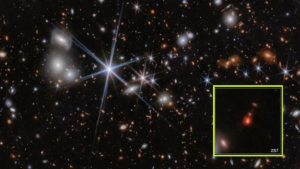
The Webb Space Telescope Makes Historic Discovery: Earliest Recorded Black Hole Merger Found
In a groundbreaking revelation, the Webb Space Telescope has uncovered the earliest documented merger of black holes. Occurring a mere 740 million years post-Big Bang, this cosmic event represents the most distant detection of merging black holes to date, as per scientists’ report on Thursday.
One of the colossal black holes involved dwarfs our sun by a staggering 50 million times in mass. Meanwhile, its counterpart, believed to be of similar dimensions, remains concealed within dense gas, posing challenges to precise measurement.
Previously, astronomers grappled with the mystery of how supermassive black holes attained their immense size.
The most recent discoveries, detailed in the Monthly Notices of the Royal Astronomical Society, propose that mergers play a pivotal role in the rapid growth of black holes – even during the universe’s early stages, remarked lead author Hannah Ubler from the University of Cambridge.
“Since cosmic dawn, massive black holes have wielded profound influence over the evolution of galaxies,” stated Ubler.
Launched in 2021 as the anticipated successor to NASA’s Hubble Space Telescope, Webb stands as the largest and most advanced observatory ever deployed into space. A collaborative endeavor between the United States and Europe, this infrared observatory scans the cosmos from a vantage point 1 million miles (1.6 million kilometers) distant from Earth.



